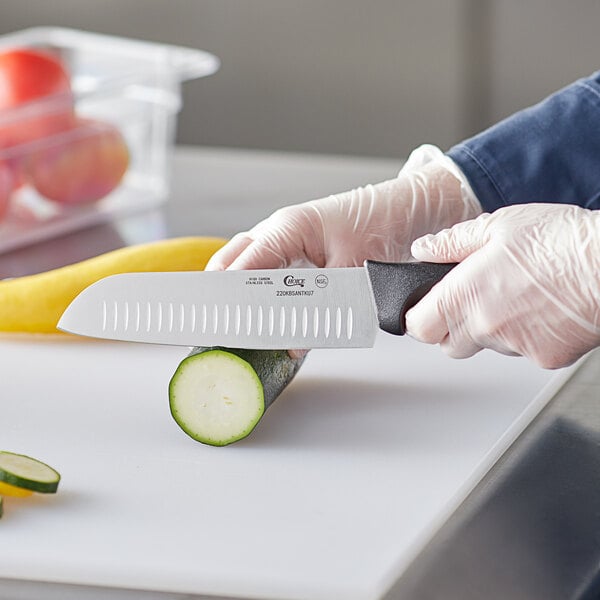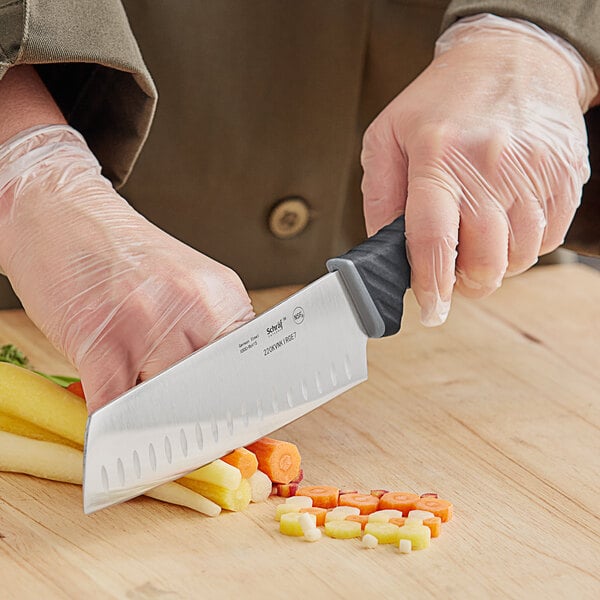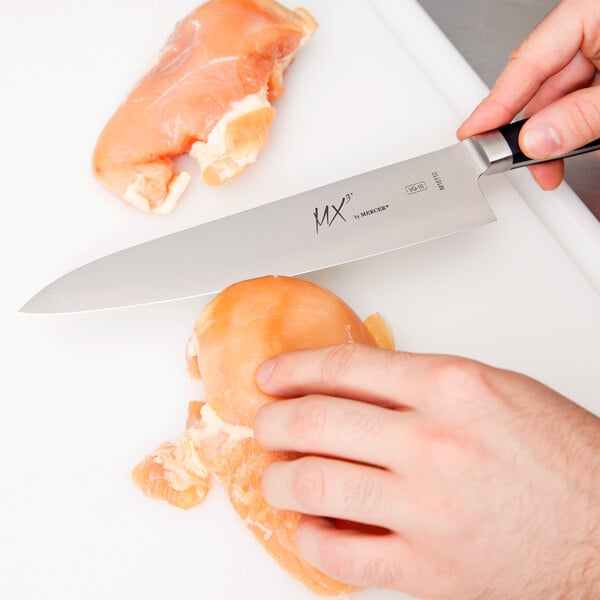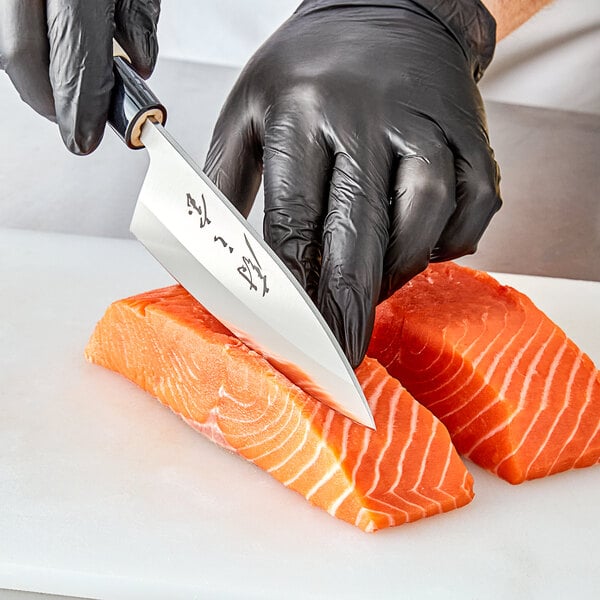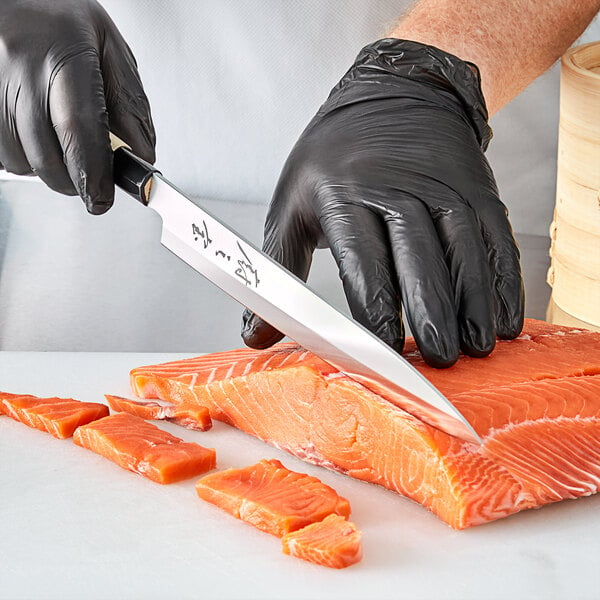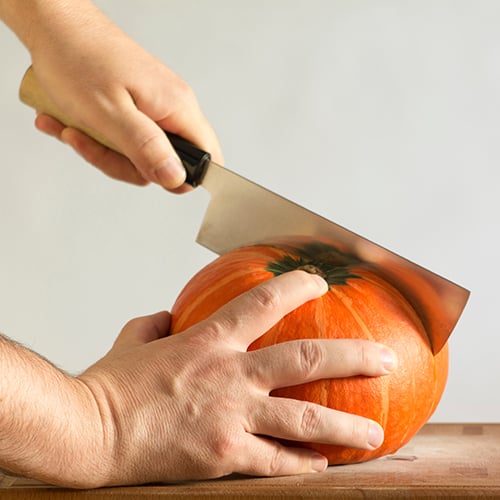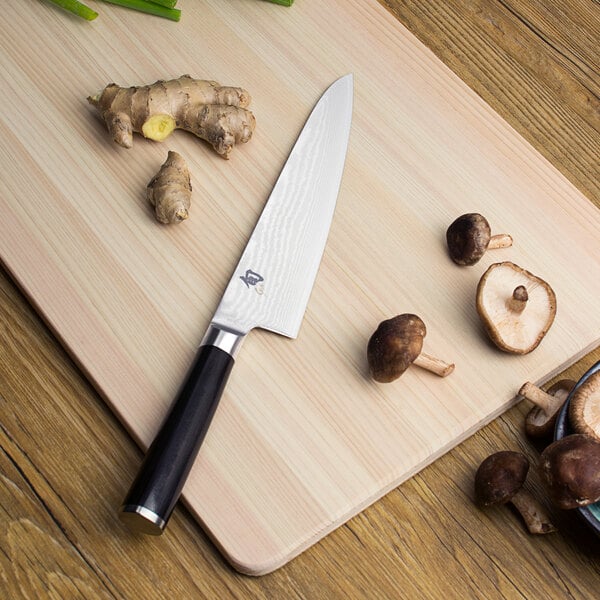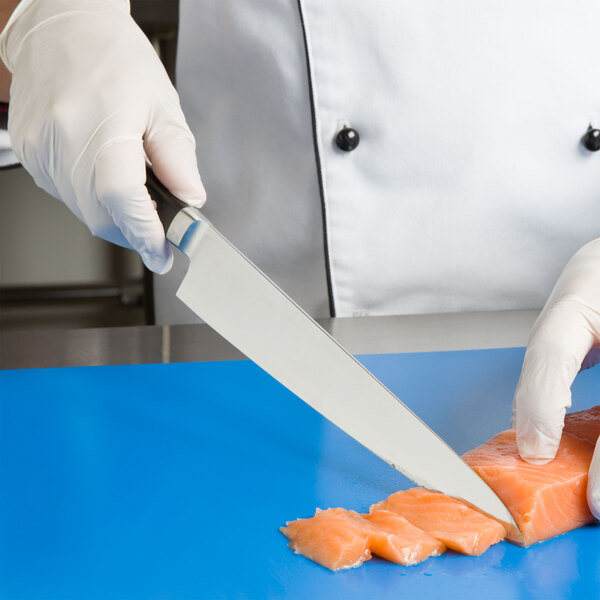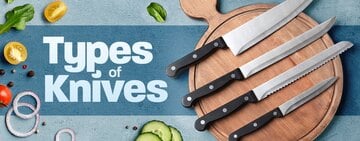We outline the most popular styles of Japanese chef knives and their uses so you can make informed purchasing decisions.
1. Santoku Knife
One of the most common Japanese knives in commercial kitchens is the santoku knife. The word santoku translates to "three virtues" in Japanese, highlighting the knife's capability to excel in three main functions: chopping, slicing, and dicing. It is one of the most versatile Japanese chef's knives.
The santoku knife is distinguished by its wide, sheep's foot-shaped blade with a flat spine that curves down to a rounded tip, resembling a "sheep's foot." Its rounded, blunt tip sets it apart from other knife styles and gives it a unique profile. The santoku knife blade ranges from 130 mm to 200 mm. Some santoku knives may also feature a granton edge, which helps prevent food from sticking to the blade.
- Santoku Knife Shape: Wide, sheepsfoot-shaped
- Santoku Knife Length: 130 mm to 200 mm
- Santoku Knife Uses: Vegetables, fruits, fish, boneless meats
2. Nakiri Knife
A nakiri knife is a Japanese vegetable knife designed for chopping produce and heavy-duty prep work. Its thin, sharp blade with a flat edge and squared-off tip allows for more complete contact with the cutting board. It achieves clean, uniform cuts.
Whether cutting bok choy or chopping a variety of vegetables for a salad, nakiri knives are essential tools for commercial kitchens seeking precision in vegetable preparation. They have a little more heft and forward balance compared to similar-sized santokus or gyutos, as there is more steel in the front of the knife. Their size typically ranges from 120 mm to 240 mm.
- Nakiri Knife Shape: Thin, flat edge, squared tip
- Nakiri Knife Length: 120 mm to 240 mm
- Nakiri Knife Uses: Vegetables
3. Gyuto Knife
The gyuto knife is the Japanese version of the classic Western-style chef's knife. In Japanese, the word gyuto translates to "cow sword," reflecting the knife's origins and its traditional use in Japanese cuisine for cutting steaks. Not just for cutting meat, a gyuto knife is also ideal for cutting fish and vegetables, making it a go-to knife for chefs who need a reliable tool for various food preparation tasks.
One of the key features of the gyuto knife is its ability to maintain a sharp edge for an extended period, reducing the need for frequent sharpening and ensuring consistent cutting performance. The typical blade length of a gyuto knife ranges from 180 mm to 300 mm, providing chefs with the flexibility to handle different cutting tasks efficiently. The gyuto knife blade features a flatter heel and a curved belly, allowing for seamless rocking while chopping or slicing ingredients.
- Gyuto Knife Shape: Thin blade, flat heel, slightly curved midsection, pointed tip
- Gyuto Knife Length: 180 mm and 300 mm
- Gyuto Knife Uses: Meat, fish, vegetables fruits, herbs
4. Deba Knife
Deba knives, also known as hon-deba, are a type of Japanese chef knife traditionally used for cleaning, filleting, and deboning whole fish. They're also commonly employed for breaking down and dressing poultry and other meats with small bones. However, they are not recommended for chopping through large bones. The spine of the deba knife tapers considerably along its length, allowing for a thin and sensitive tip that enables the user to discern whether the knife is in contact with bones.
The tapered blade, coupled with the stout handle of the deba, creates a point of balance centered at the heel of the blade. Its balance and thin blade tip make the deba knife surprisingly adept at delicate tasks. Deba knives typically range from 150 mm to 330 mm, offering versatility for various cutting needs in commercial kitchens.
- Deba Knife Shape: Thick blade, tapered, pointed tip
- Deba Knife Length: 150 mm to 330 mm
- Deba Knife Uses: Fish, small-boned meats
5. Sujhiki Knife
Sujihiki knives have thin, double-bevel, straight blades with a pointed tip. They are the modern, double-bevel counterpart to the traditional single-bevel yanagiba slicer knife. Sujihiki knives typically range in size from 210 mm up to 360 mm.
Japanese sujihiki knives are specifically crafted for filleting meat and fish, and their design allows for smooth, clean cuts through proteins without tearing or shredding the meat. They're a popular choice for sushi and sashimi preparation. Additionally, sujihiki knives are ideal for carving large roasts (like turkeys), meat, and removing sinew with finesse.
- Sujihiki Knife Shape: Thin, straight cutting edge, double bevel edge, pointed tip
- Sujihiki Knife Length: 210 mm to 360 mm
- Sujihiki Knife Uses: Carving large cuts of meat, sashimi, single cuts of meat
6. Sashimi Knife
There are three main types of sashimi knives commonly used in commercial kitchens: yanagiba, takohiki, and fuguhiki. When selecting a sashimi knife for your commercial kitchen, consider the type of fish or seafood you're cutting to choose the most suitable sashimi knife style. The yanagiba knife is a long, thin blade with a single bevel edge, designed specifically for slicing raw fish with minimal tearing. Its sharpness and long blade length make it ideal for creating thin, uniform slices of sashimi.
The takohiki knife is similar to the yanagiba in shape but features a squared-off tip, making it easier to cut through thicker pieces of fish. This knife is often used for cutting octopus sashimi and other types of seafood that require a more robust blade. The fuguhiki knife is specifically designed for slicing blowfish, known as fugu in Japanese cuisine, and it has a flexible blade that allows for precise cuts when preparing this delicate and potentially dangerous delicacy.
- Sashimi Knife Shape: Yanagiba: long slender blade, single bevel edge, pointed tip. Takohiki: long slender blade, single bevel edge, flat tip. Fuguhiki: thinnest of the three blades, single bevel edge, pointed tip.
- Sashimi Knife Length: 210 mm to 360 mm
- Sashimi Knife Uses: Slicing sashimi, seafood
7. Usuba Knife
The usuba knife is a traditional Japanese knife that is specifically designed for vegetable preparation. It's characterized by its long, rectangular-shaped blade with a single bevel and straight cutting edge. These knives typically range from 165 mm to 240 mm. They have thin blades ideal for intricate and precise cuts.
One unique feature of the usuba knife is its wa-handle, a traditional Japanese handle style. Wa-handle blades feature d-shaped, octagonal handles, and oval grips that provide a comfortable and secure hold for chefs during use. Due to its design and functionality, the usuba knife is particularly well-suited for Japanese push-cutting techniques.
- Usubu Knife Shape: Long, thin, rectangular, straight cutting edge, single bevel edge
- Usubu Knife Length: 165 mm to 240 mm
- Usubu Knife Uses: Vegetables

